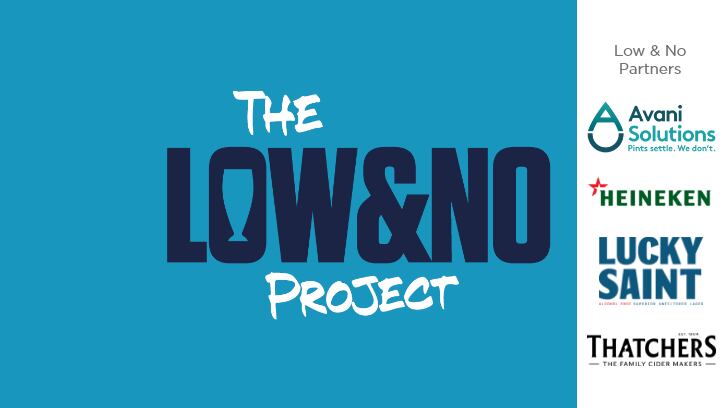The giant beer, cider and pubco – whose pub arm is Star Pubs – said low & no drinks are reshaping the on-trade landscape.
With 10.9% of customers now opting for alcohol-free alternatives when dining or drinking out (1), and the category reaching £226m (2), operators have a golden opportunity to boost revenue and meet evolving consumer demands.
Below, is some great advice to elevate your low & no sales and drive trade.
1. Offer a wide and varied range
A successful low & no offering begins with your range. It’s no longer enough to stock a single alcohol-free lager or a basic soft drink.
Today’s guests expect to see thoughtful, curated options that show you’ve considered their needs.
Most drinkers will stay category-loyal, therefore venues looking to drive more footfall will find real value in stocking low & no alcohol alternatives across all categories.
Beer remains the most popular low & no alcohol category so broadening the low & no alcohol beer range to include different styles including lagers, stouts and IPAs, will get the best results.
Our portfolio includes Birra Moretti Zero, which is now worth £5.1m with a sales value of increase of 13.6% (3), and Heineken 0.0, which is worth £30.1m, with a sales value increase of 6.5% (4).
While we do see sales peak in summer, cider options also perform well all year round, helping operators tap into customers who are seeking refreshing, flavourful drinks.
The cider category is varied, and it’s important that pubs and bars offer similar variety in their alcohol-free ranges. For example, Old Mout Alcohol Free is the low & no equivalent of our premium flavoured cider in Berries & Cherries and Pineapple & Raspberry variants. The brand has a sales value of £169.6k, up by an impressive 166.6% from the previous year (5).
This year, we also introduced Inch’s 0.0 – the UK’s first de-alcoholised cider. Since launching in 2021, Inch’s Cider has emerged as the UK’s fastest-growing cider brand with a remarkable 49% growth in value over the previous year (6).
2. Maximise seasonal and occasion-based opportunities
We see low & no alcohol sales peak during the same key trading periods as alcohol sales, including Halloween, Christmas and New Year’s Eve, as well during occasions such as Sober October and dry January.
While the evening remains the most prevalent time for drinking lower or non-alcoholic alternatives, we are seeing the rise of mid-week consumption, which presents an opportunity to boost sales earlier in the week when outlets are often quieter (7).
Sport remains a key driver of footfall for bars and pubs, with nearly a third of drinkers heading out to watch live games once a week (8). With its strong ties to sport, Heineken 0.0 holds a 38% volume share and ranking number one in both value and volume (9).
We are seeing more consumers are zebra striping – that is, alternating between alcoholic and non-alcoholic drinks over the course of their visit.
The growing popularity of this trend reflects a shift towards more mindful drinking and highlights the importance of stocking a good variety of moderation options supported by clear communication of the brands available.
3. Make low & no visible and accessible
Despite the value low & no alcohol drinks represent in terms of increasing spend per head when customers choose to not drink alcohol, the category often goes unseen.
One of the most common mistakes we see is when low & no alcohol options are hidden at the bottom of the menu or are difficult to find.
To truly drive sales, visibility is key.
You can make your range stand out by featuring those drinks in a dedicated section of your drinks list or integrating them throughout the menu to position them as equal to their alcoholic counterparts.
Ensuring they are visible both on and behind the bar also shows guests the options they have, improving the overall customer experience.
You need to clearly communicate the available brands and categories. In-venue, promotional materials such as posters, menus and specials boards can help increase awareness and nudge ordering decisions.
Email marketing is another useful tool for reaching regulars and promoting seasonal specials or events.
4. Empowering the team
One of the most effective ways to boost sales is by ensuring your staff are well-informed and confident in the category.
Staff are the frontline of customer interaction, and their ability to recommend, upsell and create positive experiences hinges on how well they understand the products.
Training should cover the full range of products available, key flavour profiles, and suitable pairings – just as you would with traditional alcoholic drinks. Sharing the background of brands adds depth to the customer experience and builds trust. When staff can explain why a product is unique or popular, it elevates the perceived value and increases the likelihood of a sale.
5. Build food pairings into the experience
Low & no drinks are increasingly being enjoyed alongside meals, especially by guests who want to be part of the occasion without drinking alcohol.
Pairing these drinks with food can elevate both the dining and drinking experience. Adding pairing suggestions to your menu next to key dishes is a subtle but effective way to encourage guests to try something new.
For example, pair Birra Moretti Zero with an Italian classic dish such as a wood-fired pizza.
Beyond the menu, venues can elevate the experience by hosting themed pairing nights or mindful dining events where each course is matched with a low & no drink. These occasions not only attract new audiences but also position the venue as forward-thinking and inclusive.
Sources:
[1] BrandTrack April 2025
[2] CGA OPM FULL YEAR 2024
[3] Nielsen IQ – w/e 28/12/24
[4] Nielsen IQ – w/e 28/12/24
[5] Nielsen IQ – w/e 28/12/24
[6] CGA OPMS GB Value Sales MAT % Chg vs LY P1 25.01.2025
[7] Kantar Alcovision w/e 30 Dec 2024
[8] CGA Brandtrack October 2024
[9] CGA Strategy OPM to p10 2024 (MAT)

